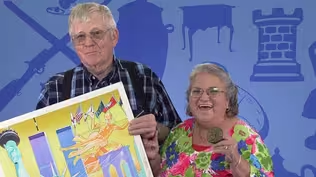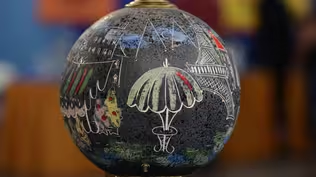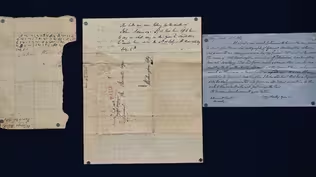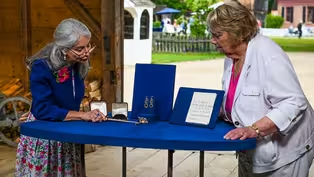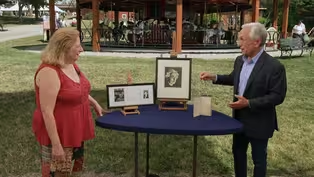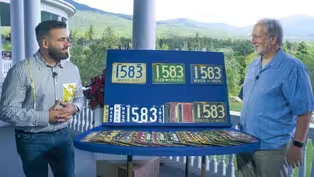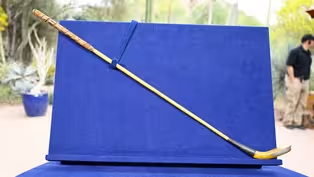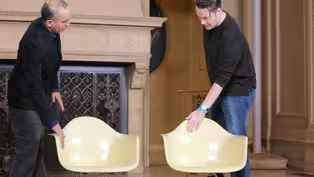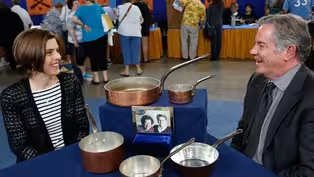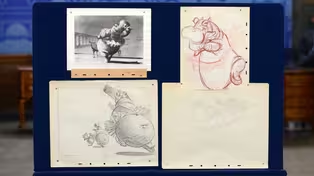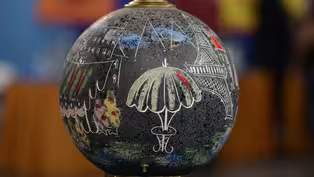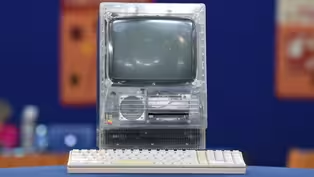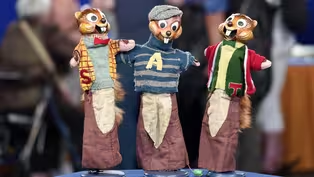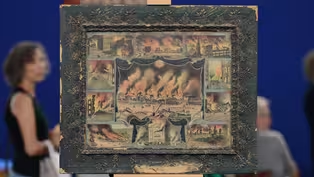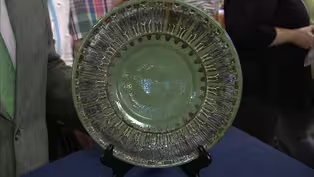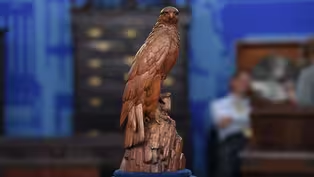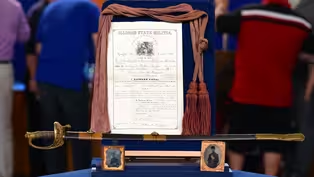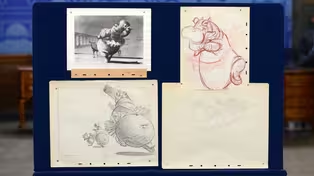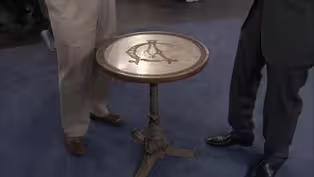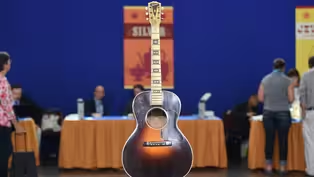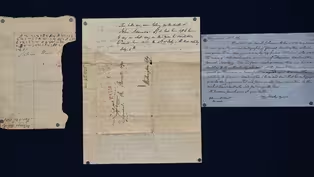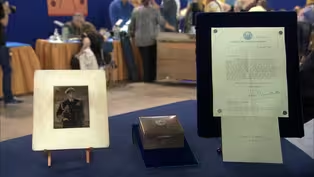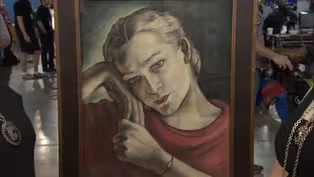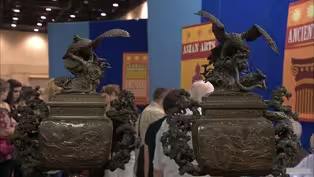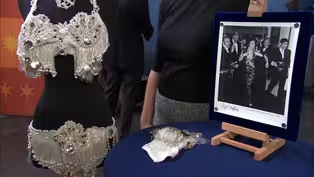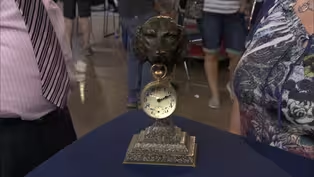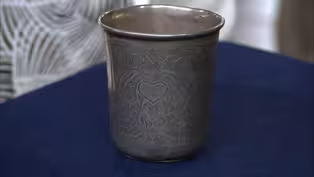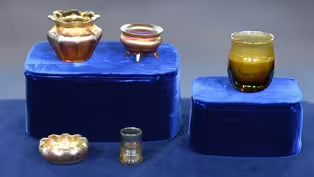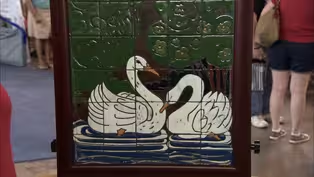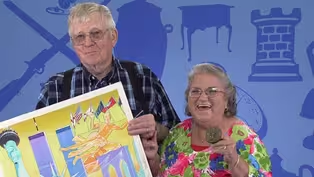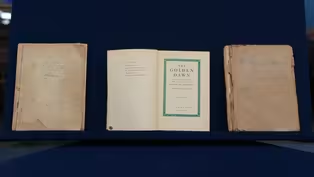
Junk in the Trunk 5, Hour 2
Season 19 Episode 33 | 53m 10sVideo has Closed Captions
Discover more previously unseen appraisals from our eight-city tour.
Discover more previously unseen appraisals from our eight-city tour, such as "Fantasia" drawings and sketches from 1940, Alvin & the Chipmunks puppets, ca. 1958, and Israel Regardie’s manuscripts and book. Which is tonight’s big find?
Problems playing video? | Closed Captioning Feedback
Problems playing video? | Closed Captioning Feedback
Funding for ANTIQUES ROADSHOW is provided by Ancestry and American Cruise Lines. Additional funding is provided by public television viewers.

Junk in the Trunk 5, Hour 2
Season 19 Episode 33 | 53m 10sVideo has Closed Captions
Discover more previously unseen appraisals from our eight-city tour, such as "Fantasia" drawings and sketches from 1940, Alvin & the Chipmunks puppets, ca. 1958, and Israel Regardie’s manuscripts and book. Which is tonight’s big find?
Problems playing video? | Closed Captioning Feedback
How to Watch Antiques Roadshow
Antiques Roadshow is available to stream on pbs.org and the free PBS App, available on iPhone, Apple TV, Android TV, Android smartphones, Amazon Fire TV, Amazon Fire Tablet, Roku, Samsung Smart TV, and Vizio.
Buy Now
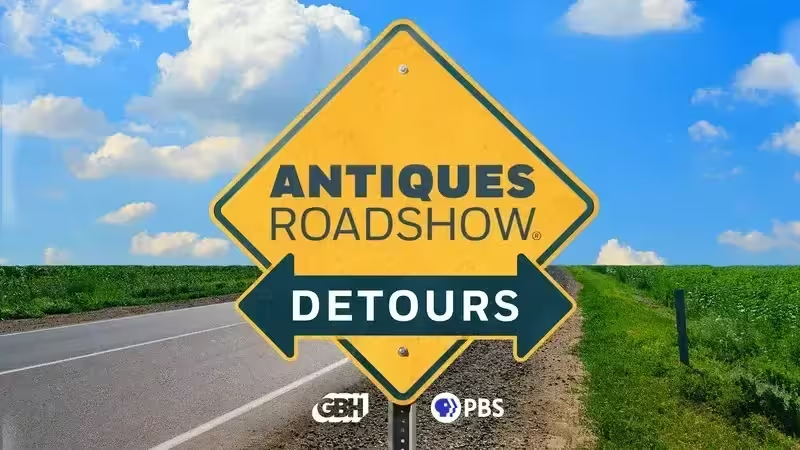
ANTIQUES ROADSHOW DETOURS
Ever wondered what happens to the treasures featured on America’s beloved ANTIQUES ROADSHOW after the cameras leave town? Host Adam Monahan tracks down the juicy afterlives of your favorite finds from PBS’s hit series.Providing Support for PBS.org
Learn Moreabout PBS online sponsorshipMore from This Collection
Check out all of our Junk in the Trunk specials!
Video has Closed Captions
Travel to all five cities of ROADSHOW's Season 28 Tour for never-before-seen appraisals! (52m 25s)
Video has Closed Captions
Catch a trunkful of never-before-seen treasures from ROADSHOW's season 27 tour. (52m 26s)
Video has Closed Captions
Discover all new appraisals from ROADSHOW’s Season 26 tour, like a find of up to $75,000! (52m 27s)
Video has Closed Captions
Discover never-before-seen surprises from our Season 24 tour. One is worth up to $100K! (52m 45s)
Video has Closed Captions
Discover never-before-seen appraisals from all Season 23 cities, like a $40K-$60K find! (52m 29s)
Video has Closed Captions
ROADSHOW’s bigger-than-ever 2014 season includes a second hour of junk! (53m 10s)
Providing Support for PBS.org
Learn Moreabout PBS online sponsorshipMARK WALBERG: It's another Antiques Roadshow special episode of extra treasures we discovered on the road during our season 19 tour.
MAN: This painting used to belong to my great-uncle George, who had perhaps the best job in the world-- he owned a brewery.
WALBERG: There's more to come in this second hour of Antiques Roadshow-- Junk in the Trunk.
Stay tuned.
Welcome to Antiques Roadshow!
So excited!
Oh, my gosh, this is so awesome!
WALBERG: There was an enthusiastic crowd in New Mexico.
Welcome to Antiques Roadshow.
Hi, I'm Mark Walberg.
We're in Albuquerque, aren't we, folks?
EVERYONE: Yeah!
WALBERG: There was no monkey business when it came to this precious primate.
MAN: This painting used to belong to my great-uncle George, who had perhaps the best job in the world-- he owned a brewery up in Lancashire in the north of England.
And it passed from him to his daughter, who was my mother's cousin, and then from my mother to me.
APPRAISER: Do you have any idea where your great-uncle got the painting?
I don't have any idea at all.
Have you ever found a signature on it?
I hadn't before today, or any sort of means of being able to discover who the artist was, and still no signature that I'm aware of.
We took the paper which covered the back of the picture, and we were lucky enough to find a label that said, "G. Lance" with the title "Black Cap, Monkey, and Fruit."
So I did a little checking, and there is a Victorian still-life painter named George Lance.
He was born in 1802 in Essex.
And he showed artistic talent quite early on.
And one day he encountered Charles Landseer, who was drawing in the British Museum.
And he asked Landseer who his teacher was, and he said it was Benjamin Haydon.
And the very next day, Lance went off to meet with Benjamin Haydon and ended up becoming his apprentice for about seven years.
So he studied with him and at the Royal Academy as well.
One of Lance's early patrons was a man named Robert Vernon.
He was a big art collector.
And his collection became what was to become the Tate Museum.
And one of the pictures he bought from Lance was a picture called The Red Cap.
And it shows a monkey wearing a red cap.
The Red Cap was painted in 1847.
There's really some wonderful detail here with the hatpin and the peacock feather, and just the embroidery here on the jacket.
He's got quite a wonderful ensemble on, and he's just about to cut into this melon, it looks like, and drooling.
I think he's already had some, or he's anticipating.
Yes.
So the medium is oil.
It's painted on panel, which is basically a piece of wood.
And you have it framed under glass, which keeps it lovely and clean, but actually, to see the painting in the best possible way, I would recommend removing the glass.
When was the last time you had the picture appraised, and for how much?
I want to say it was about three or four years ago, and it was appraised, because nobody knew anything about its provenance, at, I think, $2,000 to $3,000.
George Lance was instrumental in sort of bringing still-life painting back into the forefront in the 1830s and 1840s.
He died in 1864, but had quite a successful career.
And in today's market, the 19th century painting market is not as strong as it had been.
And I think at auction it might be $20,000 to $30,000, today's market.
I think it would be appropriate to say, "By George," wouldn't it?
WOMAN: I bought this lamp about 20 years ago at a thrift store here in Albuquerque.
I just thought it was too cool, because it was scenes of Paris, and it has the holes in it, and the lights come through and the buildings of Paris.
What I love about it the most is this Fauvist interpretation of Paris at the time.
And what I think we've got here is this homage to Raoul Dufy.
This lamp is a painted, glazed, and carved ceramic atomic age lamp.
And it's made by the Tye of California company, which was active in the Los Angeles area in the 1950s.
And it's signed and marked "Tye," and dated 1954.
And that's very interesting, because that's just one year after Raoul Dufy passed away.
So this really great, vibrant depiction of Paris starts here on the front with this Caf\ de Paris, and then it continues around with the Eiffel Tower, and then some diners dining outside.
And if I go back the other way, it starts out with one of these great corner kiosks that you see throughout Paris, where various posters are posted.
One of the most fun things about this, I think, are these holes that are drilled throughout, so that the light that emanates from within comes out, and it looks like it's the beautiful street scene of Paris at night.
One of the things I love doing is having only this light on in the room, so that all you see are the lights in the windows, and it's pretty beautiful.
So you almost feel like you're in Paris.
Yeah, you get to just look at it, and the room is dark except for the little glowing lights.
The only thing I'm curious about is what kind of shade it would have, or what it should have.
I think this would have had a very 1950s circular drum form shade, perhaps something you would have seen on an episode of I Love Lucy.
Right.
So tell me, when you found this at that thrift store, what did you pay for it at the time?
I think I paid $20 for it.
Okay.
I think you got a pretty good deal.
I've seen a lot of Tye of California lamps on the market.
This has to be the best example I've ever seen.
Really?
Wow.
And by far the most interesting, the most decorative, the most aesthetically appealing.
And if I were to advise you... Uh-huh?
...on an insurance value, I would say you should insure this for $1,200.
Cool.
That's great.
Well, I'm not selling it.
It's a great thing.
I promised it to my daughter, so it's staying in the family.
WOMAN: When I was 16, I was in the basement with my mother, and discovered this.
She had had it hanging behind some other things.
And she told me that it came from my grandparents' house, that the frame is plastered, and that it was originally gold colored.
But because it was so brilliant, my grandparents took stove blackening and blackened the frame.
And that's all I know about it.
That was the end of the gold frame.
Yes, that was the end of the gold frame.
It's a color lithograph from 1904 showing great American fires.
The center fire happens to be Baltimore, where I'm from, so I've actually owned one of these one time years ago.
But I've only seen one in the last 30 years of buying and selling old prints.
So it's quite a scarce item.
It's got all the other fires going around with lists of the number of people who died and the dollar amount of what was lost.
And the Baltimore fire has the largest dollar amount lost.
One way I know it's 1904, not any later, is they have the San Francisco fire of 1857, which is another way to date it, because they're talking about that fire rather than the 1906 fire, which hasn't happened yet.
So that way I know it's 1904 or 1905.
This is the Chicago fire from 1871.
Some of the titles are sort of worn off on these.
Yeah.
I love some of the little details in it.
You've got the black drapery, in mourning, and then the crossed axes.
It doesn't have an artist.
The last one I had years ago, I don't remember seeing a printer's name on it either.
It's not what's called a fine art print, but to me, it's just a great example of Americana.
You do have condition problems.
Yes.
There's tears here, there's a loss here.
You've got roughness in some of the other edges.
But condition on this kind of thing is in relation to rarity.
If it's really rare, condition's less of a factor.
It doesn't help, but it's not going to hurt it as much as if it's a common print.
I would say a retail value price on it would be somewhere in the neighborhood of $1,200 to $1,500, about $1,200 to $1,500.
I'm amazed.
Wow.
Thank you.
My father gave this to me.
He was a sergeant in the Southeast Asian command.
He was a U.S. official photographer, and he was also a professional artist.
And he did several portraits of Louis Mountbatten, five in total.
He was not allowed to accept monetary compensation, so as a token of Mountbatten's appreciation and likeness of his portraits, he gave my father this cigarette box.
What's interesting about this is your father was a sergeant in the United States Army, not in the British Royal Navy, as Mountbatten was.
Here we have a letter from Southeast Asia Command Headquarters, which Mountbatten ran, and he talks about your father in it.
And like you said, because of the fact he couldn't take any money, there's a line in here that says, "I gratefully accept the portrait, "and since I understand that it is against regulations "to offer you an honorarium, "I hope that you will accept instead "a small engraved cigarette box and framed photograph as a token of my gratitude."
Is this the photograph?
That's the photograph of the painting.
It's a really interesting set.
Do you have any idea of its value?
I have no idea.
It's just been a family heirloom.
I would put an auction estimate of $1,000 to $1,500 on it.
Yeah, it's a great grouping of stuff, it really is, really is.
Lola was my husband's aunt, and she lived in Manhattan her whole life.
And she grew up there.
And in the '20s she worked at a nightclub, and she just had a really exciting life, and that's how this painting came about.
Who's the artist of the painting?
The artist is Mary Elizabeth Hutchinson.
I know that she was from Atlanta.
She painted in New York in the '30s.
And I know that she had a retrospective at the Atlanta Art Museum probably about ten years ago.
But that's about all I really know about her.
And you know that there was a relationship between her and Lola.
Yes-- Lola used to tell me every time she sat for her for this portrait, Mary would pursue her and her affections.
And Lola liked Mary a lot and loved the painting, but she wasn't quite prepared to go that far for a sitting.
Well, with all that we know about artists, we know there's often relationships that develop between artists and their sitters.
But it's pretty clear that the artist admired Lola a great deal, and she painted her as a very beautiful woman.
But you have photographs that the artist also took of Lola...
Yes.
...which show that she was indeed a stunningly beautiful young woman.
She was very beautiful.
She was a cigarette girl at the Copa in New York, and she also was married to the manager of the Copa.
And she told me that that's how she met a lot of these people, you know, artists and musicians, and kind of how she gained relationships with them.
Well, she represents a whole era in New York, in that sort of glamorous period of the '20s and the '30s, when people did go to nightclubs, dress up.
Being a cigarette girl was a profession.
As far as the artist is concerned, people who watch the show regularly might know that I have kind of a particular interest in women artists.
And many of them are quite little known today, unfortunately.
We're trying to rectify that.
There are two auction records I was able to find for her.
One is a painting that's a portrait rather like this, which sold for $4,800 a couple of years ago.
So I would say that, given her reputation being as small as it is at this point, we can still say an auction estimate of between $4,000 and $6,000 on this picture.
Well, thank you so much.
Thanks for bringing it.
Yep, I think Lola would be thrilled.
I have this incredible collection of drawings and cels and other paraphernalia from the artists Lee and Preston Blair, who worked with Disney.
They worked on Fantasia and Pinocchio and Bambi.
They had a long career, as far as I know, at Disney.
Lee Blair, in fact, was the last winner of the Olympic gold medal for watercolor.
And we ended up with all of this because my grandfather befriended them when they were probably teenagers, in the late '20s.
And they had no father, and he had no children at the time.
And they just connected, and they had a lifelong friendship.
And over the years, they gave my grandfather and grandmother an amazing collection of their drawings, of their work.
You brought in a tremendous collection of items, some amazing things-- like you said, cels, storyboards, preliminary art, sketches.
I mean, there was so much to go through.
It was very difficult to choose just a few pieces.
Yes, yes.
And I chose what I thought were kind of wonderfully representational of the art leading up to Fantasia.
All four of these pieces were done by Preston Blair.
We've got a photo of a storyboard sketch over here.
And this is one of the storyboards they used for prepping the shots and trying different designs.
They'd take photos of it so they could draw on it and take notes on it without damaging things at all.
Okay.
And this is my favorite.
This one is absolutely beautiful.
Mine, too.
Tremendous color of one of the dancing hippos.
It's done in crayon, colored pencil, and it is just a tremendously beautiful piece, a riot of color, drawn on the right animation paper.
It's absolutely spectacular.
And we go down here, and it's a beautiful preliminary sketch.
It's got a few shapes and blocking, just to get the vision of what they wanted to make Fantasia into.
Right.
And over here is actually one of the sketches that they'd use for the ink and paint department to draw the actual cels on.
Okay.
So it's a great sequence showing the evolution of the design.
The sequence from Fantasia, this was called "The Dance of the Hours."
It had hippos dancing with alligators and ostriches, all dancing to La Giaconda.
And it was a great, great ballet, tremendous music.
And it is one of the most memorable pieces.
Preston Blair left Disney in 1941, just after Fantasia was produced.
Oh, okay.
Went on to work for Hanna-Barbera and Walter Lantz and the other companies.
Now, these do sell very well at auction.
And I imagine these aren't things you're necessarily going to part with, because they're very much a part of your family.
But I'm going to give you an auction estimate for each piece.
Okay.
So because this is a photograph, but it was used in the production, it's got the notes on the bottom for the sequence and which unit worked on it, at auction that would sell for around $300 to $500.
Mm-hmm, okay.
My favorite... just look at her.
Just a wonderful smile, the little flittering lashes.
As a preliminary sketch, that would sell for around $5,000 to $8,000 at auction.
Oh, my God.
Mm-hmm.
Wow, wow.
And this one over here, the blocking... Uh-huh.
...again, $5,000 to $8,000, too.
Geez.
Wow.
And this one, being used for the actual production of it, $2,000 to $3,000.
Wow.
(laughing): And then I just think about how much more we have, you know?
You probably have a lot of things there, between those wonderful Jiminy Cricket sketches, you had Bambi and his girlfriend in there, tremendous.
An auction value for that portion of the animation art, I would expect to see between $75,000 and $100,000.
Wow.
Wow.
I wasn't expecting that.
WALBERG: Thousands turned up for our sold-out Chicago event.
And Chi-town wasn't at all shy about showing off its treasures.
Yeah, and it's a cigarette case.
Very neat.
I got it about five years ago, and I paid about $95 for it, I think.
And how did you acquire this?
I bought it online.
And what do you know about it?
Nothing-- I could never make out the signature on the back.
So I really don't know what it is.
You must have liked it a lot to pay $95 for a plate you didn't know anything about.
Yeah, I like the ravens on it.
The decoration is certainly unusual, especially for this particular artist.
You can see on the back it's a script signature.
Anton Lang is the name of the artist.
And it is a decorative piece.
Anton Lang was a pretty interesting character, which is why I wanted to do this today.
Oh, okay.
Lang toured the world as a ceramic artist.
He even came to America for a while, and worked... worked... he played at the Rookwood Pottery in Cincinnati, Ohio.
We've seen pieces of Rookwood done by Anton Lang.
But what he's really famous for, aside from being a rather well known and lifelong potter, is he lived in Oberammergau, which is in Bavaria.
They're famous for their passion play.
And Anton Lang played Christ in the passion play.
And he was a real pacifist.
When he heard about things going on in America in the '20s when he was touring here, about the Ku Klux Klan, and he just didn't get why all these factions were fighting each other.
He said, "In Germany, where I'm from, "we have Protestants, we have Christians, we have Catholics, all living side by side."
He got in trouble as a pacifist with the Germans, because in the '30s, they wanted him to insert anti-Semitic remarks in the passion play, and he refused.
Oh, okay.
And the Germans went after him, and he went to the hospital and died in 1938.
He was born in 1875.
He died in '38 of an unknown stomach disease.
All right.
And at his funeral, none of the socialist party showed up to bereave him, even though he was quite famous.
So it's a good personal story.
On top of that, for the most part, his pottery is fairly plain.
He hand-threw pieces on a wheel.
Okay.
And the decoration, if there's any on them at all, is fairly simple.
This is the most complicated piece of Lang that I've seen, and I've seen 500 over the years.
It's a charger, it's pierced for hanging, it's got a raven design, as you said, in enamel around the border, and really quite beautiful.
Stylistically, in terms of when this was made, because of the way the ravens are stylized, that geometric quality to them is typical of German design in the teens and '20s.
Okay.
I've seen Lang's work sell for several hundred dollars from time to time.
I think at auction it would probably bring somewhere around $1,000.
Oh, wow.
Yeah, I had no idea it was worth that much.
WOMAN: Well, I've brought in my grandfather's clock that was given to me when I was about 20 years old.
He purchased it in France.
He did a lot of traveling for his business with my grandmother, who was a renowned designer.
And I was known to climb on his desk and swing it, and so that's why it was given to me.
Okay, but you've stopped doing that now.
No, I have not been swinging the clock.
Okay, all right, good.
All right.
So what we have here are actually two things.
This is a paperweight clock.
Some people call it a ball clock.
And it was made about 1900.
So it's over 100 years old.
They're very high quality.
You can see they have this wonderful movement that you can see inside the crystal.
This one is marked "France."
Most of them were made in France.
And it was meant to sit on the desk of an executive.
As a matter of fact, this has a flat area right here that's supposed to allow you to stand it up.
But someone has taken it apart and turned it so that it's upside down now.
It should be turned so that it sits like that when it's on the desk.
But it has this wonderful pedestal that it hangs on, which undoubtedly is original.
It's from the same period.
So I'm sure this was a very upscale example.
Do you have any idea of what it's worth?
Well, my dad thought it was worth about $800, but I have no idea.
Well, I've seen this paperweight clock by itself sell for not quite that much, but close to it.
I've seen these sell in the $500, $600 price range in good condition, running.
But the pedestal with this wonderful dog's head and the base with a little bit of bronze around the bottom, I mean, that's really fantastic, and it puts it into a whole different category of sculpture.
It becomes a sculpture.
And I would think that in a retail situation with the clock running that a collector would pay easily $2,000 to $2,500 for this piece.
Oh, that's great.
Well, today I brought in a collection of Civil War items that my sister and I inherited from our great-great-uncle, who served in the 27th Illinois Volunteer Infantry in Company A.
When did he serve?
He originally went in for 90 days in 1861, and then when he was discharged there, he went back to Quincy, Illinois, and along with three other people, in six days they recruited 100 men to become Company A of the 27th Illinois Volunteer Infantry.
What we have is his Civil War staff officer's sword.
And it's officially known as the Model 1850.
We have the "US" in the guard.
And like many of the swords during the time, this one was actually made in Germany and brought over for sale to well-to-do Union officers.
It would have been a privately purchased sword.
It's in the original metal and brass scabbard.
And we have a photograph of him holding the sword.
We've actually got two images of your ancestor, one a little bit earlier, and one when he was a captain.
He rose through the ranks as he stayed in during the war.
The 27th faced some fierce battles.
Do you know which battles they were in?
Well, one of the significant ones early on was the Battle of Belmont.
And they were also in the Siege of Island Ten.
My uncle was... great-great-uncle was one of the volunteers that laid on the gunboat Pittsburgh when it went through the blockade.
And then later on they were at Missionary Ridge.
They were at Chattanooga.
They saw some severe fighting.
They lost...
I think it was in the neighborhood of 188 men.
Because they served that whole campaign down through Atlanta, and very hard-fighting regiment.
This image is kind of cool, because we have his sash.
The photographer tinted the sash.
Originally the sash that we have here would have been a bright crimson color.
And it has aged, because of the dyes in the material, to this pretty tone that we have today.
What about the document-- what is this?
He was promoted to captain, field promotion, and then later on the actual document was created, signed by Governor Yates, promoting him to captain.
And that's nice to have with this sword, because this is the sword that would go with that rank.
And it's beautiful condition.
They're pre-printed, nicely filled in, and it is signed by the governor.
And it's just a wonderful group to have all the pieces, because so many times you'll see a sword, you'll see a sash, but we don't know who they belong to.
And with this one, we not only know who it belonged to, we've got an image of him wearing it, which, to a collector, is a very special thing.
As a group, it's something that I would insure for about $4,000.
Okay.
That's what we needed to know.
WOMAN: They were given to my father back in the '60s as a gift.
And then I inherited them.
APPRAISER: It's Japanese incense burners from the Meiji period, around 1890s, 1880s.
It's cast bronze.
The casting quality is fantastic.
And I maybe assume it was made for expositions.
This is a pair, and I would say $4,000 to $6,000 at the auction.
Yes.
When you pulled this out of its carry-on case, it elicited oohs and ahs from everybody around.
Tell us a little bit about this.
Well, a friend of my husband's gave this to him in the early '90s.
And he had worked for Apple Computer since the beginning.
And we did not have a computer, so he gave us this.
And what he said is that he worked on this project, and so the folks who worked on it were each given the computer in this clear acrylic case.
But other than that, I don't know anything about it.
It's a Mac SE from 1987.
Oh, wow.
But it doesn't look like every other Mac SE from 1987, because it has this incredible translucent case.
And you can see all the inner workings of the computer.
And it kind of reminds you of a computer that would come around ten, 12 years later, the iMac, with the transparent case.
But much earlier.
Just amazing-- an amazing piece of industrial design.
Oh, thank you.
We're dealing with a time, now, when there's a new frontier of collectibles, things that the kids and young adults of the '80s were playing with and using.
And boy, does this fit into a category like that.
Oh, great.
A certain limited number of them were given to employees, people who worked on this project.
Right.
The fact that you knew one of them, and you actually obtained one, boy, the provenance is impeccable.
Oh, cool.
Oh, that's great.
Yeah, it's wonderful.
This is a museum-type piece.
Oh, wow.
And as such... and I wouldn't insure it for anything less than $10,000.
No way-- are you kidding me?
It really appreciated.
Oh, my gosh, oh.
Yeah, I think they sold for a couple thousand dollars originally, but of course, this was a special one.
Oh, you're kidding.
Get out of here.
Oh, my gosh.
That'll pay somebody's tuition for, like, a couple weeks.
(both laughing) WALBERG: New York City's amazing art and antiques never disappoint, whether they're on display at places like the New York Historical Society... APPRAISER: Here's a wonderful painting by the American Impressionist Childe Hassam.
WALBERG: ...or in front of our Roadshow cameras.
WOMAN: These are the Chipmunks: Alvin, Simon, and Theodore.
And I have them because my father-in-law made these puppets, and he performed with them on the Ed Sullivan Show, and as far as I know, also on American Bandstand with Dick Clark.
He also had other puppets and puppet shows, and he had a children's television puppet show.
But when they passed, the whole collection came to our house, all these puppets, and we had to do something with them.
But we held on to the Chipmunks.
How did you store them when you had them in the house?
Oh, you probably don't want to hear that.
In a place of great honor, or... No, in the bottom drawer of a filing cabinet.
We had a lot of puppet things for a long time, and we just didn't have room.
And we didn't know, and...
I mean, we kind of knew to be careful with them, but no, they were not in a place of great honor.
So they're finally, after all these years, getting a day out on the town in New York.
And the interesting thing about this is that the Chipmunks were created by, stage name, Dave Seville, which was Ross Bagdasarian.
Yes.
And he was an entertainer and a singer.
And then he stepped up into the puppeteering with the Chipmunks.
And interestingly enough, he sang his songs, and then he fast-forwarded them onto the... however they did it, reel to reel, or... and that came up with the squeaky chipmunk voices.
Did your dad know Dave Seville?
It was my father-in-law, actually-- my husband's father.
Right.
Yes, he worked with Dave Seville for years.
When you look at puppets in general, general terms, not very valuable.
The puppet market and puppet collectors, it's not big money involved.
However, when you're looking at something that's iconic... and I use that word meaning these are items that in history, people are going to look at this show and they're going to say, "I remember that day, it was 1958 and I was watching Ed Sullivan, and up came the Chipmunks."
And the other thing you have to put in perspective is that the Chipmunks... not that these are living creatures, but they were the first animated singing group that had a number one hit.
Everybody remembers "Walla Walla Bing Bang," and can't forget that.
So they're really a part of American history, a part of American culture.
Terrific condition, all these years, with the Alvin and the Theodore and the Simon, all with their initials on the shirts.
You can see the A in the Alvin.
Yeah, he even has a T on his little sweater over here.
Absolutely, and it's just a wonderful thing.
And you had mentioned people looking, and they're laughing, but they're laughing with a smile.
And that's what's important about this stuff, because it brings you back to when you were a kid.
And not just that, but keeping in mind that they made their first appearance in 1958.
We're in 2014, and they're still popular, with movies, cartoons.
When it comes to valuing something like this, I'm going to put it in terms of what you should insure them for.
Because personally, I'm fairly confident you're going to want to keep these in the family.
Absolutely.
But if that's the case, then I would certainly put no less than a $10,000 insurance value on them.
Worth every bit of that.
For the three of them?
For the three of them.
Put a $10,000 insurance value on all three.
Okay.
You know, this is the kind of thing that really could go into the Smithsonian as an exhibit, and I'm glad you brought them to us today.
And it's wonderful that my father-in-law made them.
Like, that's even more wonderful for the family.
Which is great for your family.
WOMAN: My grandfather worked for Tiffany's in Corona.
These pieces were seconds and would not be sold.
And he would bring them home to my grandmother, who really did not like them at all.
And these were the ones that she had kept.
And the other ones she had buried in the backyard.
Did your grandfather ever talk about what it was like to work there?
He said that it was very, very hard, the hours were very long, and that it was very tedious.
Oftentimes I have seen pieces that have come into families through someone who had actually worked at Tiffany Studios.
Yes.
At the glassworks in Corona, Queens.
Yes.
And what's interesting about your story, when you say that they're seconds, four out of the five pieces are unsigned.
And it was not uncommon for the unsigned pieces to go home with the people who worked at Tiffany studios.
So that further corroborates the story.
Now, what's interesting is the one piece that is signed, which is this piece... and this is a very, very early piece.
And this is signed.
It bears a registration number with a prefix letter C, which indicates that this was made between 1895 and 1896.
Oh, wow.
Do you know exactly the years that your grandfather worked there?
It would be in the late teens, 1919, maybe.
Right.
Around in there.
Okay, well, so this probably sat around at Tiffany Studios for a long time before it went home with someone.
Isn't that something?
But let me show you.
It's very corroded on the inside.
Yes.
And that's probably why it was considered a second.
It's strange that they did bother to sign it.
So that's kind of a little mystery for me.
But I've seen this on a lot of the very early pieces.
But this is so unusual, because three of these are gold iridescent pieces, whereas this is almost like a paperweight that actually is faceted like honeycombs.
Yes.
And then there's a wonderful variation in the glass.
It's sort of a root beer color, and then it progresses to more of a golden color.
The four other pieces, with the exception of the signed piece, those are later pieces.
And those could have been made anywhere from 1900, as late as 1925, or even 1930.
In terms of value, this one, in a retail venue, would sell for about $500.
This one in a retail venue would sell for about $250.
This is kind of a funny little piece.
That was always my favorite.
And he has said that it was made for a woman to put her lipstick in.
Well, it is possible, but I also think it might be a little shot glass, believe it or not.
Oh, that would work, okay.
And it's a little more unusual also, because it's transparent instead of gold iridescent.
Okay.
This one probably would be worth in the neighborhood of about $75 to $100.
This piece here would be about $500 or $600 in a retail venue.
Oh, my.
And this piece, even though it's the most interesting of all, the problem is it has the corrosion.
It's interesting, but probably only worth about $300 or $400.
Oh, that's fine.
So if this were in perfect condition, this could have been maybe $1,000 to $1,500.
Oh, my, oh, my.
WOMAN: This belonged to my great-aunt up in New Hampshire, and it was given to me.
I thought it was a very handsome lap desk.
I loved the box.
And then when we opened up the contents and found these wonderful letters and documents, it really was very fascinating.
But I really don't know a great deal about it.
They enjoyed going to different estate sales, and I imagine they picked it up over the years at some point.
I really don't have any history on it.
It was interesting to note that when we opened the box up, there was documentation indicating that it had belonged to Artemas Ward.
And he was a general in the American Revolution.
Yes.
And a graduate of Harvard University.
Mm-hmm.
And there were some documents here that have his name on them.
Yes, yes.
Well, Artemas Ward, not only was he a general in the Revolutionary War, he served his country also in peace.
He went on to be a congressman from Massachusetts.
And what's so interesting about this collection is you really see this material from the 18th and through the 19th century.
And the first piece that you pointed out, the letter that... partial letter that we have here from Artemas Ward himself, in his handwriting, which has some sort of code on it...
Fascinating.
So this is an 18th century piece of paper that remains to be decoded, if you will.
There's also letters that go through the centuries, and we move into the 19th century.
Want to just read that paragraph for us?
Certainly.
It's stating, "The bells are now tolling "for the death of John Adams.
"If it had been left to him to say "on which day in the year he should die, "he would have selected the fourth of July.
He died yesterday."
This was signed July 5.
Yes, exactly.
So we've got Artemas Ward writing this letter, but we know that it was not done by the father Artemas Ward who was the general, but rather his son, junior.
Here is a contemporaneous account of the death of John Adams.
They were all friends.
I mean, Artemas Ward knew George Washington.
I mean, so this is American history coming alive.
Beautiful.
And then to move forward, later in the 19th century you see a letter also here which states that the family is donating an autograph of George Washington for a fundraiser.
Unfortunately, we don't have the... ...have the autograph, yes, unfortunately.
So let's get into this lap desk, which is English made.
And if we flip it around, we can see how the lap desks were meant to be used.
You would have written on this.
This desk was not owned by Artemas Ward, Sr.
It was owned by his son, because of the date of this.
He, Artemas Ward, died in 1800, and this desk was probably made in 1820 to, say, 1840.
In it is this wonderful cache of other artifacts from early New England history.
We've got a French letter opener with beautifully enameled handle.
There is a... shot, it's for hunting, in leather.
Do you know what this is?
I don't.
This I'm intrigued by.
Yeah, well, if you were writing in the 19th century, you would have had your pen... this is a porcupine pen.
And when you dipped your pen into the ink here, it would have been a little drippy, so you would have taken it and wiped off... pen wipe is what it is.
Pen wipe.
So we think about the package as a whole, we look at a lap desk like this, it's probably in the $600 range.
We're looking at some of the various documents.
We have another $1,000 or so in the documents.
And then with the other artifacts, if I were to find this group of things in an antique shop, I think I would expect to pay in the $2,000 to $4,000 range for the whole package.
Wonderful.
I'm thrilled.
Thank you.
It's so nice to have an answer to this.
MAN: It was a Christmas gift from my parents somewhere in the mid-'50s, and I've had it ever since.
APPRAISER: And you've had it ever since.
Here you've lived in Manhattan, you've had this in an apartment in New York.
Queens, actually.
Oh, Queens.
Right.
I mean, I'm always amazed when somebody keeps a toy from that period of time that long and in such great condition.
It's a prized possession.
It really is.
Well, these were very expensive in their day.
Most kids were told by their parents, "Take care of it," so we do have these show up once in a while in this condition, because it is... but it's super.
What's interesting, as we say, it's from the 1950s, it's Lionel.
Of course, Lionel was the top train for anybody to have in those days.
They made some of the best.
'50s was sort of the late era for Lionel.
But certain sets really have a sort of magic from that era.
And this happens to be one of them.
It is plastic, plastic locomotive.
What I like about this, this is the Jersey Central line.
They would make a lot of different railroad lines, but the Jersey Central in this configuration is really nice.
And of course, this was before Amtrak.
Now they're all Amtrak.
But there were all these separate lines running.
This is a very modern set with the aluminum cars with the observation thing, which... more like you saw out West.
You didn't see them too much in Jersey.
What I love about this set, it has that wonderful bullet nose rear end, which is... of course, that's where the club car was, where you'd go back for your martinis as you're cruising through North Jersey.
I love that you have the boxes.
We love those.
Always the boxes.
They're really, really crisp.
A set like this, in this condition, could bring around $4,000 to $6,000 at auction.
Wow.
You did mention this all came in a big set box-- do you remember that?
No memory of that whatsoever.
I just presume that it came in a set box.
Oh, yeah, it came in a set box, and it had some labels.
No memory.
The set box for this set, $1,000.
Wow.
WOMAN: We have a belly dancing costume of my mother's, Ozel Turkbas.
My father and my mother met making a movie together.
My father had several movies made, and when they first met, making my mother's first movie, they immediate fell in love, and my father became my mother's manager.
So they traveled the world, and my mother belly-danced for the Prince of Monaco and all over the world.
And she was in the opera ThaĂŻs.
She has several albums-- Alla-Turca, How to Belly Dance for your Sultan, many books.
She was quite an amazing woman.
She always danced within... from her soul, and it really came out.
What you brought is a classic, beautiful, custom belly dancing costume.
It's got a choker, the halter top, the bottom, and over on the table we have one of the two wrist pieces.
Yes.
I was so happy you also had a whole bunch of photos of your mom and your mom and your dad together.
When was the last time she danced professionally?
I believe in 1979.
Okay.
I was two years old and crying in the background, and she said, "That's it."
Hard to be a working mom.
Yes, yes, yes.
There has been a huge resurgence in belly dancing.
It's a wonderful artistic and athletic sport.
Really in the last five to ten years it's really kind of... it's taken off.
Belly dance classes.
This is exactly what they still wear.
It's a very traditional kind of look.
Of course, your mom's is uber special.
And so what I'm going to tell you is for replacement purposes, because I know they're your family's, and they're not ever going to be sold.
And my replacement value is based on what it would cost to have a custom piece made.
There's not a huge circle of collectors in the belly dancing per se.
And so of the ones that you've brought here today, and this is one of the most beautiful ones, they would cost $3,000 to replace.
That should be your insurance, for a total of $18,000 for what you've just brought today.
Wonderful.
WALBERG: Our final stop brought us to West Virginia's state capital, Charleston.
I got it from a lady at a yard sale.
She couldn't get rid of it, and so she gave it to me.
So you actually got it for free?
I got it for free.
WALBERG: And one lucky guest's suspicions were confirmed when he discovered his treasure was a very rare bird indeed.
MAN: Well, this has been in my family, I guess, since the '60s, or maybe 1970.
In the early '80s my grandfather was approached by a local company that made figurines out of walnut shells.
And they look like wood, so they approached him, and he allowed them to make a mold of this.
And it became their top seller.
So there are a bunch of copies out there, but I've got the original.
This is the real deal.
Well, let's talk about that a little bit.
There's a company by the name of Red Mill Manufacturing in Fishersville, Virginia, that did reproduce this.
Yes.
And they actually did it with pecan shells and some resin, and they built, essentially, what became wood-like copies.
And they're often sold at auction as wood carvings, and they're not.
Oh, wow.
And you're absolutely right.
If you go research Red Mill, you'll find there's... this eagle shows up a lot.
Yeah.
And it doesn't sell for terribly much money.
Right.
You'll see a Red Mill eagle sell for $25, or $40, and there's not a lot to it.
Yep.
But this one is... there's something exceptional about it.
What we have here is a carved eagle in the Black Forest style, and more than likely done in the Black Forest.
Oh, okay.
When you're dealing with Black Forest carvings, we see tons of them.
We see them... they come into the show all the time, and we're constantly going through them.
And when I looked down and I saw this first, I was like, "That just has presence, it has personality, it's screaming at you the whole time."
Oh, yeah.
And that's what is absolutely magnificent about this particular piece.
It does have some damage.
We do see here... at the tip of the beak we see a break on the beak.
Coming around on the front here we see a talon that's missing.
Now, if this came up to auction today, I would anticipate it would be conservatively estimated between $1,200 and $1,800.
Mm-hmm.
Well, it's staying in the family.
I don't blame you.
I think if it was mine, I wouldn't let it go either.
Yeah.
My late husband purchased it from someone that he knew.
He said that he found it in Philippi, West Virginia, after a really bad flood that happened there years ago.
All right.
And he also checked with a museum in Philippi, West Virginia, to see if they knew anything about it, and they said they lost a lot of items during that time, but they wasn't sure if it was something from their museum or not.
So we've been trying to find out some information about the cup for years, but we haven't found anything.
Oh, really, okay.
Well, as we can see, it has been in the wars a little bit, so I can imagine this particular cup sort of tumbling down the stream, as it were, in the flood, because there's all of these sort of dings and dents along the lower edge.
It's made in Russia.
It's made in Moscow.
Okay.
In 1860.
It's a large beaker, and it displays a lot of the workmanship that is typical of Moscow of that period.
So I'll just show you, if you look at the strapwork, all of that's very classically Russian, sort of pan-Slavic style.
We've got this building.
And then finally you've got this heart shape enclosing the date, 22nd of November 1861.
So it's probably made for some kind of commemoration, you know, maybe something to do with the large houses.
I mean, oftentimes when you see these, they have Moscow monuments in them like the Kremlin, or something like that, all sort of engraved.
So for this to have these two houses, I think, is a little bit more unusual.
It's a really good size as well, another thing that sort of sets it apart from lesser ones.
The quality of the engraving is also very good on this one.
I think if it was to come for auction, this would probably be worth in the region of $800 to $1,200.
Okay.
If it was in perfect condition, maybe more like $1,200 to $1,800.
All right.
All right, well, thank you.
MAN: It was our great-uncle's, from Steubenville, Ohio, and he got it, we believe, brand new in 1929, 1930.
And then it's been passed down through the family since then.
It's just been sitting in the closet ever since.
It's barely been used, I'd say.
APPRAISER: Do you know the name of it?
Gibson?
(both laugh) It is a Gibson.
Very good.
And it's got a really interesting story.
Now, what can you tell me that's kind of different about this instrument?
I would assume the inlaid neck.
Right.
But other than that, I'm not a guitar player, so I wouldn't know.
Okay.
These were actually introduced by Gibson to commemorate the 1933 World's Fair in Chicago, which had the official name of the Century of Progress Exposition.
Okay.
So it ran from 1933 to 1934.
And the Gibson company, in anticipation of this World's Fair, decided to make use of a new material that has a trade name of Pearloid.
It is a material made with nitrocellulose.
Right.
And it's extremely flammable, and at the time, it was very difficult to produce.
So back in the early '30s, this was considered something to be very exotic.
The size of the guitar in Gibson's catalogue is designated as the L series.
So this one has the official name of the L-Century.
It was a very limited production run.
It ran about six or seven years before they changed the facing on the fingerboard and the headstock to rosewood.
And today, it's actually quite rare to see one in such good condition.
Because it's a relatively unstable material, these usually have some kinds of issues with them-- cracks, separations.
This guitar has almost no issues.
Right.
It has this little nick on the bottom.
Right.
And one of the bridge pins went missing at some point.
Yeah, I can see that.
But they are beautiful sounding guitars, and this one happens to be the best example I have ever seen.
I would give it a retail value of between $6,000 and $6,500.
Okay, great, thank you.
MAN: I have two manuscripts of my uncle Francis Israel Regardie, plus one of his books that is annotated with a message on it.
I have had these about 20 years, the manuscripts.
I got them from my father, and he had them.
But they're from the 1930s.
APPRAISER: Israel Regardie was your uncle?
Yes, that is correct.
Well, as you already well know, Israel Regardie, along with Aleister Crowley, were the two men of the modern occult movement of the early 20th century.
Yes.
Mr. Regardie was originally Aleister Crowley's secretary in the Golden Dawn, or the more fuller name, the Hermetic Order of the Golden Dawn.
The Golden Dawn was a secret society of alchemists and mystical people and occultists that came out of the 19th century and really coalesced under Aleister Crowley in the early 20th century.
It was an extremely secretive order, and their rites and rituals were only allowed to initiates.
Israel Regardie respected Aleister Crowley a lot, and he created a great stir in the modern occult movement when he published their secret rites and rituals in this very book before us, The Golden Dawn by Israel Regardie.
This is a family copy, I believe.
Yes.
It has the bookplate here of your father.
It's my father, right.
And then this inscription reads, "For Mom and Dad, with love, Izzy."
Right.
The Golden Dawn is really regarded as the book that started the modern occult movement.
With it today, you've brought two important original manuscripts by your very famous uncle, including a partial manuscript here of The Golden Dawn itself.
Right.
It's not the complete book, but just the introductory pages.
Right.
And we have a second manuscript over here that had an interesting story in that the title got changed.
Can you tell me about that?
Well, you can see on the title here, it says, "Light in Extension."
And he crosses out "Light in Extension" in the book and puts in "My Rosicrucian Adventure."
Yes.
And that's the name the book got published under.
These two Israel Regardie manuscripts were written throughout the 1920s, but The Golden Dawn wasn't actually published until 1938.
Do you have any idea of the value of the material?
None whatsoever.
In fact, I've had them for about 20 years now, and I was thinking, are they worth keeping or not?
I would value the two manuscripts and the family signed book at retail between $20,000 to $25,000.
My goodness, very nice.
Incredibly unusual to find Regardie manuscript material.
I wish I had more of it.
WALBERG: We hope you enjoyed this special edition of Antiques Roadshow "Junk in the Trunk."
Stay tuned for the Feedback Booth right after this.
And now, it's time for the Roadshow Feedback Booth.
I brought what I thought was my Dogon fetish, but it turns out it's Congolese, and it scares the children.
It scares me, too.
I brought in these earrings that were given to me by an ex-boyfriend back in, I don't know, 1990?
He was kind of a jerk, and I haven't seen him in 20 years.
He paid $350 for them.
I found out today they're worth maybe $120.
And that made my whole day.
He got ripped off, and vengeance is sweet.
I bought this very interesting vase at an estate sale because my mom collects stuff like this, pottery and stuff.
So I take it home, and I was just like, "Mom, I got something for you."
But then I looked at it, I was just like, "I think it's worth a million dollars."
So I said, "You can't have it."
So I brought it to the Roadshow, and it's not worth a million dollars, so she can kind of have it now.
Okay, give it here.
I brought Hawkes/Steuben vase.
Wonderful appraisal, but nothing like getting... swooning over the Keno brothers.
Hugs and kisses.
Waited so long.
Thank you.
I'm Mark Walberg, thanks for watching.
See you next time on Antiques Roadshow.
Hey, guys.
Look at this stuff-- Pawnee Bill!
What do you know about this?
Captioned by Media Access Group at WGBH access.wgbh.org
Appraisal: 1940 "Fantasia" Drawings & Sketches
Video has Closed Captions
Clip: S19 Ep33 | 3m 45s | Appraisal: 1940 "Fantasia" Drawings & Sketches, from Junk in the Trunk 5, Hour 2. (3m 45s)
Appraisal: 1954 Tye of California Ceramic Lamp
Video has Closed Captions
Clip: S19 Ep33 | 2m 45s | Appraisal: 1954 Tye of California Ceramic Lamp, from Junk in the Trunk 5, Hour 2. (2m 45s)
Appraisal: 1987 Translucent Mac SE
Video has Closed Captions
Clip: S19 Ep33 | 1m 53s | Appraisal: 1987 Translucent Mac SE, from Junk in the Trunk 5, Hour 2. (1m 53s)
Appraisal: Alvin & the Chipmunks Puppets, ca. 1958
Video has Closed Captions
Clip: S19 Ep33 | 3m 10s | Appraisal: Alvin & the Chipmunks Puppets, ca. 1958, from Junk in the Trunk 5, Hour 2. (3m 10s)
Appraisal: "America's Great Fires" Lithograph, ca. 1905
Video has Closed Captions
Clip: S19 Ep33 | 2m 23s | Appraisal: "America's Great Fires" Lithograph, ca. 1905, from Junk in the Trunk 5, Hour 2. (2m 23s)
Appraisal: Anton Lang Rookwood Plate, ca. 1920
Video has Closed Captions
Clip: S19 Ep33 | 2m 27s | Appraisal: Anton Lang Rookwood Plate, ca. 1920, from Junk in the Trunk 5, Hour 2. (2m 27s)
Appraisal: Black Forest Carved Eagle, ca. 1900
Video has Closed Captions
Clip: S19 Ep33 | 2m 5s | Appraisal: Black Forest Carved Eagle, ca. 1900, from Junk in the Trunk 5, Hour 2. (2m 5s)
Appraisal: Civil War Union Officer Group
Video has Closed Captions
Clip: S19 Ep33 | 3m 5s | Appraisal: Civil War Union Officer Group, from Junk in the Trunk 5, Hour 2. (3m 5s)
Appraisal: Fantasia Drawings & Sketches
Video has Closed Captions
Clip: S19 Ep33 | 3m 45s | Appraisal: Fantasia Drawings & Sketches, from Junk in the Trunk 5, Hour 2. (3m 45s)
Appraisal: French Inlaid Presentation Table, ca. 1906
Video has Closed Captions
Clip: S19 Ep33 | 1m | Appraisal: French Inlaid Presentation Table, ca. 1906, from Junk in the Trunk 5, Hour 2. (1m)
Appraisal: Gibson L-Century, ca. 1932
Video has Closed Captions
Clip: S19 Ep33 | 2m 32s | Appraisal: Gibson L-Century, ca. 1932, from Junk in the Trunk 5, Hour 2. (2m 32s)
Appraisal: Lap Desk with General Artemas Ward Archive
Video has Closed Captions
Clip: S19 Ep33 | 3m 49s | Appraisal: Lap Desk with General Artemas Ward Archive, from Junk in the Trunk 5, Hour 2. (3m 49s)
Appraisal: Lionel New Jersey Central Train Set, ca. 1955
Video has Closed Captions
Clip: S19 Ep33 | 1m 59s | Appraisal: Lionel New Jersey Central Train Set, ca. 1955, from Junk in the Trunk 5, Hour 2 (1m 59s)
Appraisal: Louis Mountbatten Cigar Case & Letters
Video has Closed Captions
Clip: S19 Ep33 | 1m 26s | Appraisal: Louis Mountbatten Cigar Case & Letters, from Junk in the Trunk 5, Hour 2. (1m 26s)
Appraisal: Mary Elizabeth Hutchinson Portrait
Video has Closed Captions
Clip: S19 Ep33 | 2m 17s | Appraisal: Mary Elizabeth Hutchinson Portrait, from Junk in the Trunk 5, Hour 2. (2m 17s)
Appraisal: Meiji Period Japanese Incense Burners
Video has Closed Captions
Clip: S19 Ep33 | 28s | Appraisal: Meiji Period Japanese Incense Burners, from Junk in the Trunk 5, Hour 2. (28s)
Appraisal: Ozel Turkbas Belly Dancing Costume, ca. 1970
Video has Closed Captions
Clip: S19 Ep33 | 1m 58s | Appraisal: Ozel Turkbas Belly Dancing Costume, ca. 1970, from Junk in the Trunk 5, Hour 2. (1m 58s)
Appraisal: Paperweight Clock with Polished Stone Stand, ca.
Video has Closed Captions
Clip: S19 Ep33 | 2m 10s | Appraisal: Paperweight Clock with Polished Stone Stand, ca. 1900, from Junk in the Trunk 5 (2m 10s)
Appraisal: Russian Engraved Silver Beaker, ca. 1860
Video has Closed Captions
Clip: S19 Ep33 | 1m 50s | Appraisal: Russian Engraved Silver Beaker, ca. 1860, from Junk in the Trunk 5, Hour 2. (1m 50s)
Appraisal: Tiffany Favrile Glass Vessels
Video has Closed Captions
Clip: S19 Ep33 | 3m 37s | Appraisal: Tiffany Favrile Glass Vessels, from Junk in the Trunk 5, Hour 2. (3m 37s)
Appraisal: Tile Plaque, ca. 1920
Video has Closed Captions
Clip: S19 Ep33 | 30s | Appraisal: Tile Plaque, ca. 1920, from Junk in the Trunk 5, Hour 2. (30s)
The Junk in the Trunk 5 Feedback Booth
Clip: S19 Ep33 | 2m 57s | Guest from our Season 19 events share their trash to treasure tales (2m 57s)
Appraisal: Israel Regardie Manuscripts & Book
Video has Closed Captions
Clip: S19 Ep33 | 3m 5s | Appraisal: Israel Regardie Manuscripts & Book, from Junk in the Trunk 5, Hour 2. (3m 5s)
Providing Support for PBS.org
Learn Moreabout PBS online sponsorship
- Home and How To

Hit the road in a classic car for a tour through Great Britain with two antiques experts.













Support for PBS provided by:
Funding for ANTIQUES ROADSHOW is provided by Ancestry and American Cruise Lines. Additional funding is provided by public television viewers.


